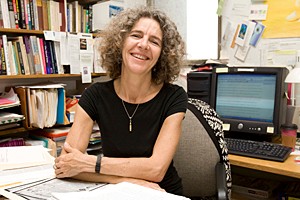
Witness to the Execution: Family Members of Victims Pose a Growing Challenge for Capital Punishment
An examination of the nations history in carrying out executions is encountering a new challenge for modern-day capital punishment. Bringing in family members of victims to witness executions brings about a new source of pressure on the execution, complicating actual execution arrangements and the position of capital punishment in the public imagination, according to Annulla Linders, a University of Cincinnati associate professor of sociology. Linders research, titled, Bearing Witness: Victims Relatives and Challenges to the Execution Narrative, was presented this at the 109th Meeting of the
American Sociological Association
in San Francisco.
Linders research explores how family members of victims bearing witness to executions has transformed the process of the execution as well as its audience. How can we account for this recent transformation of the execution and its audience and what are the consequences of this change for understanding executions specifically, and capital punishment more generally, writes Linders. I argue that the opening up of the witness box to the murder victims family has turned the execution into a somewhat different kind of event than it was it has come to re-personalize executions and re-infuse them with interestedness and passion, states Linders. No longer is it enough that the death is swift and the arrangements are efficient, the execution must now also satisfy the psychological demands of long-suffering relatives and other intimates of murder victims.
Thirty-two U.S. states still carry death penalty laws. Linders reports that prior to the 1990s, Louisiana was the only state by law to allow intimates of victims to witness executions. That number grew to five states by 1996. Linders says currently 18 states allow the presence of victims relatives to witness the execution.
As a result, not only has execution technology made executions a more sterile and efficient event, says Linders, but they now are expected to bring some sort of emotional satisfaction (relief, peace) or closure to the families.
The process of the execution erupted in national controversy following the so-called botched lethal injection execution of Clayton Lockett in Oklahoma last April. The event brought about a nationwide stay on executions until Georgia, Missouri and Florida carried out lethal injection executions within 24 hours of each other, beginning on June 17.
Linders findings come from researching newspaper accounts of executions dating back to the 19th century. Her research in the Library of Congress newspaper archives traced accounts of executions ranging from 19th century public hangings to current execution chambers typically requiring 12 official witnesses to the event. The first laws calling for removal of public executions were adopted in the 1830s.
The paper details several national newspaper reports of families witnessing executions of the convicted murderer of a family member, as well as the reports describing family members feelings following the execution. The paper begins with the execution of the so-called Freeway Killer, convicted serial killer William Bonin, who in 1996 became the state of Californias first person to die by lethal injection, and the third to be executed in California after the U.S. Supreme Court reinstated the death penalty in 1977.
Neither morbidly curious spectators (in the old sense of public executions) nor disinterested witnesses (in the new sense of closed executions), the family members of murder victims are in the witness box to view and judge something other than the execution of the law, writes Linders. They are there as survivors, not so much to observe the execution there are official witnesses to do that as to bear witness to the pain and suffering experienced by murder victims and those they leave behind.
Funding for the research was supported by the University of Cincinnati
Charles Phelps Taft Research Center
in the
McMicken College of Arts and Sciences
.
Related Stories
How to keep birds from flying into your windows
July 3, 2024
UC College of Arts and Sciences professor Ron Canterbury tells the Indianapolis Star that simple steps can prevent birds from strike windows around your home or business. Yahoo! News shares the story.
Meet UC’s Miss Ohio
July 1, 2024
UC biomedical science student Stephanie Finoti credits UC for helping to prepare her for the Miss Ohio Scholarship Pageant. She will represent Ohio in the national competition in January.
UC alum credits journalism program with early success
June 26, 2024
Zachary Jarrell came to the University of Cincinnati in 2019 to pursue a degree in statistics. In 2023, he graduated with a Bachelor’s in Journalism. For many undergraduates, the journey through college rarely takes the expected track. Detours happen, and majors change. When plans switch up, it can be helpful to a student’s success to find support. For Jarrell, it was the people he worked alongside in the journalism department who helped him on his journey. It has left a lasting impression on his life so far, guiding him to multiple internships as an undergraduate, real-world experience in prominent news outlets, and eventually a successful career in the highly competitive field of journalism.
